JohnQuixote
Ideal_Rock
- Joined
- Sep 9, 2004
- Messages
- 5,212
To be concise, this thread is about:
1. Cut grade conflicts caused by the forced rounding in GIA's new system.
...The cut grade GIA assigns will vary (a) depending which direction the actual angles are rounded in, and (b) if necessary adjustments aren't made to overall depth - perhaps girdle thickness too - when this forced rounding occurs.
2. GIA appears to be downgrading diamonds with non-traditional brillianteering even when the approach is additive.
...This goes against prior assertions that girdle approaches would have to be 'deleterious' to receive a downgrade.
3. Perhaps more as we go.
[ The next several posts were discussed in the 2006 GIA Grading Report thread, page 3. These types of issues appear to be surfacing in public now, so I am reposting it again with a consumer heading ]
GIA Cut Grades (Facetware and online): Adjustments for rounding
The GIA grading system appears not to make necessary adjustments in depth, girdle (and perhaps other parameters) when the software default-rounds angles.
Some time ago Strmrdr pointed out a depth adjustment necessary due to FW rounding and I put these examples together for our staff. These were done with the old interface, but the results are the same with the new one.
Hopefully this will be useful info for anyone who will be using (or who's clients will be using) the software.
Example A: You may receive different grades depending on your rounding choice
Depth: 60.8
Table: 55
CA: 35
PA: 40.7
Star: 50
LH: 80
Girdle: Thin to Medium
Culet: N
Polish: Ex
Sym: Ex
In this example the diamond’s PA is 40.7. Your choice between 40.6 and 40.8 is the difference between EX or VG/worse. Facetware awards EX when you choose to enter 40.6 (likely because the CA is high at 35.0 and 40.8 would make the diamond too steep for its tastes). Thus, two different grading implications can be produced for any diamond with these measurements.
Consider also that any diamond with a 34.8 or 34.9 CA average will be forced to 35 in FW, so you will be faced with the same choice in FW for any of these combined with 40.7.
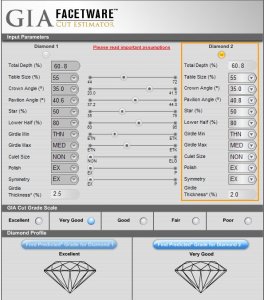
1. Cut grade conflicts caused by the forced rounding in GIA's new system.
...The cut grade GIA assigns will vary (a) depending which direction the actual angles are rounded in, and (b) if necessary adjustments aren't made to overall depth - perhaps girdle thickness too - when this forced rounding occurs.
2. GIA appears to be downgrading diamonds with non-traditional brillianteering even when the approach is additive.
...This goes against prior assertions that girdle approaches would have to be 'deleterious' to receive a downgrade.
3. Perhaps more as we go.
[ The next several posts were discussed in the 2006 GIA Grading Report thread, page 3. These types of issues appear to be surfacing in public now, so I am reposting it again with a consumer heading ]
GIA Cut Grades (Facetware and online): Adjustments for rounding
The GIA grading system appears not to make necessary adjustments in depth, girdle (and perhaps other parameters) when the software default-rounds angles.
Some time ago Strmrdr pointed out a depth adjustment necessary due to FW rounding and I put these examples together for our staff. These were done with the old interface, but the results are the same with the new one.
Hopefully this will be useful info for anyone who will be using (or who's clients will be using) the software.
Example A: You may receive different grades depending on your rounding choice
Depth: 60.8
Table: 55
CA: 35
PA: 40.7
Star: 50
LH: 80
Girdle: Thin to Medium
Culet: N
Polish: Ex
Sym: Ex
In this example the diamond’s PA is 40.7. Your choice between 40.6 and 40.8 is the difference between EX or VG/worse. Facetware awards EX when you choose to enter 40.6 (likely because the CA is high at 35.0 and 40.8 would make the diamond too steep for its tastes). Thus, two different grading implications can be produced for any diamond with these measurements.
Consider also that any diamond with a 34.8 or 34.9 CA average will be forced to 35 in FW, so you will be faced with the same choice in FW for any of these combined with 40.7.



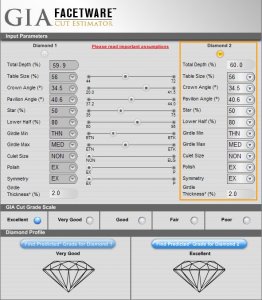
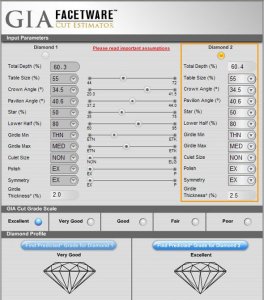


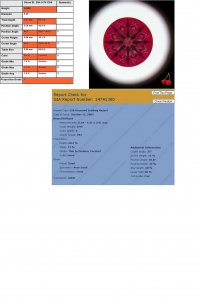
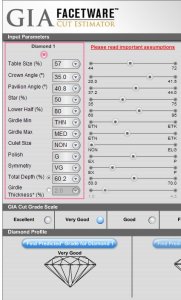
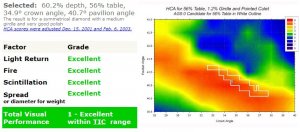
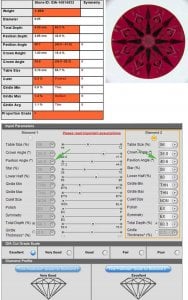
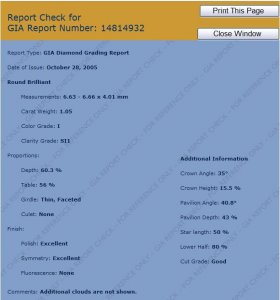

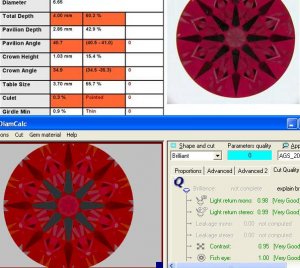
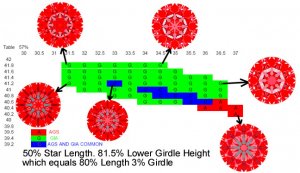


300x240.png)